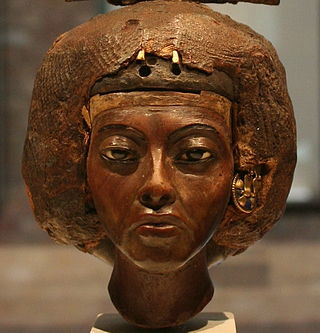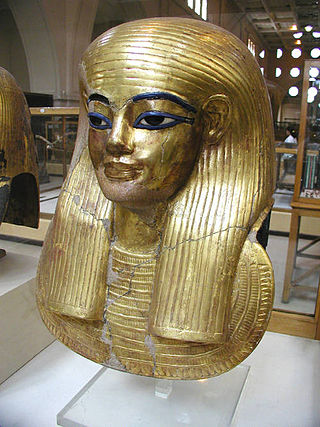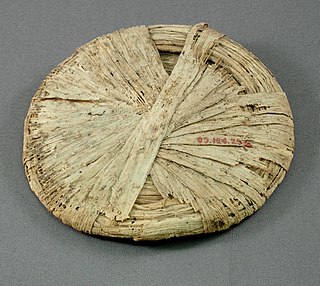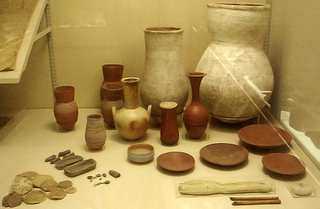
Tutankhamun, Tutankhamon or Tutankhamen, also known as Tutankhaten, was the antepenultimate pharaoh of the Eighteenth Dynasty of ancient Egypt. He ascended to the throne around the age of nine and reigned until his death around the age of nineteen. The most significant actions of his reign were reversing the religiopolitical changes enacted by his predecessor, Akhenaten, during the Amarna Period: he restored the traditional polytheistic form of ancient Egyptian religion, undoing the religious shift known as Atenism, and moved the royal court away from Akhenaten's capital, Amarna. Also, Tutankhamun was one of few kings worshipped as a deity during his lifetime; this was usually done posthumously for most pharaohs.

Tiye was the Great Royal Wife of the Egyptian pharaoh Amenhotep III, mother of pharaoh Akhenaten and grandmother of pharaoh Tutankhamun; her parents were Yuya and Thuya. In 2010, DNA analysis confirmed her as the mummy known as "The Elder Lady" found in the tomb of Amenhotep II (KV35) in 1898.

Zahi Abass Hawass is an Egyptian archaeologist, Egyptologist, and former Minister of State for Antiquities Affairs, serving twice. He has also worked at archaeological sites in the Nile Delta, the Western Desert, and the Upper Nile Valley.

KV55 is a tomb in the Valley of the Kings in Egypt. It was discovered by Edward R. Ayrton in 1907 while he was working in the Valley for Theodore M. Davis. It has long been speculated, as well as much disputed, that the body found in this tomb was that of the famous king, Akhenaten, who moved the capital to Akhetaten. The results of genetic and other scientific tests published in February 2010 have confirmed that the person buried there was both the son of Amenhotep III and the father of Tutankhamun. Furthermore, the study established that the age of this person at the time of his death was consistent with that of Akhenaten, thereby making it almost certain that it is Akhenaten's body. However, a growing body of work soon began to appear to dispute the assessment of the age of the mummy and the identification of KV55 as Akhenaten.

Smenkhkare was an ancient Egyptian pharaoh of unknown background who lived and ruled during the Amarna Period of the 18th Dynasty. Smenkhkare was husband to Meritaten, the daughter of his likely co-regent, Akhenaten. Since the Amarna period was subject to a large-scale condemnation of memory by later Pharaohs, very little can be said of Smenkhkare with certainty, and he has hence been subject to immense speculation.

The tomb of Tutankhamun, also known by its tomb number, KV62, is the burial place of Tutankhamun, a pharaoh of the Eighteenth Dynasty of ancient Egypt, in the Valley of the Kings. The tomb consists of four chambers and an entrance staircase and corridor. It is smaller and less extensively decorated than other Egyptian royal tombs of its time, and it probably originated as a tomb for a non-royal individual that was adapted for Tutankhamun's use after his premature death. Like other pharaohs, Tutankhamun was buried with a wide variety of funerary objects and personal possessions, such as coffins, furniture, clothing and jewelry, though in the unusually limited space these goods had to be densely packed. Robbers entered the tomb twice in the years immediately following the burial, but Tutankhamun's mummy and most of the burial goods remained intact. The tomb's low position, dug into the floor of the valley, allowed its entrance to be hidden by debris deposited by flooding and tomb construction. Thus, unlike other tombs in the valley, it was not stripped of its valuables during the Third Intermediate Period.

Tomb KV60 is an ancient Egyptian tomb in the Valley of the Kings, Egypt. It was discovered by Howard Carter in 1903, and re-excavated by Donald P. Ryan in 1989. It is one of the more perplexing tombs of the Theban Necropolis, due to the uncertainty over the identity of one female mummy found there (KV60A). She is identified by some, such as Egyptologist Elizabeth Thomas, to be that of the Eighteenth Dynasty pharaoh Hatshepsut; this identification is advocated for by Zahi Hawass.

Tomb KV46 in the Valley of the Kings is the tomb of the ancient Egyptian noble Yuya and his wife Thuya, the parents of Queen Tiye and Anen. It was discovered in February 1905 by Chief Inspector of Antiquities James E. Quibell, excavating under the sponsorship of American millionaire Theodore M. Davis. Despite robberies in antiquity, the undecorated tomb preserved a great deal of its original contents including chests, beds, chairs, a chariot, and numerous storage jars. Additionally, the riffled but undamaged mummies of Yuya and Thuya were found within their disturbed coffin sets. Prior to the discovery of the tomb of Tutankhamun, this was considered to be one of the greatest discoveries in Egyptology.

Yuya was a powerful ancient Egyptian courtier during the Eighteenth Dynasty of Egypt. He was married to Thuya, an Egyptian noblewoman associated with the royal family, who held high offices in the governmental and religious hierarchies. Their daughter, Tiye, became the Great Royal Wife of Amenhotep III. Yuya and Thuya are known to have had a son named Anen, who carried the titles "Chancellor of Lower Egypt", "Second Prophet of Amun", "Sm-priest of Heliopolis", and "Divine Father".

Thuya was an Egyptian noblewoman and the mother of queen Tiye, and the wife of Yuya. She is the grandmother of Akhenaten, and great grandmother of Tutankhamun.

Tomb KV21 is an ancient Egyptian tomb located in the Valley of the Kings in Egypt. It was discovered in 1817 by Giovanni Belzoni and later re-excavated by Donald P. Ryan in 1989. It contains the mummies of two women, thought to be Eighteenth Dynasty queens. In 2010, a team headed by Zahi Hawass used DNA evidence to tentatively identify one mummy, KV21A, as the biological mother of the two fetuses preserved in the tomb of King Tutankhamun.

Tomb KV54 is located in the Valley of the Kings, in Egypt. It was originally excavated by Edward R. Ayrton on behalf of the American lawyer Theodore M. Davis, who funded the work.

KV63 is a chamber in Egypt's Valley of the Kings pharaonic necropolis. Initially believed to be a royal tomb, it is now believed to have been a storage chamber for the mummification process. It was found in 2005 by a team of archaeologists led by Dr. Otto Schaden.

KV64 is the tomb of an unknown Eighteenth Dynasty individual in the Valley of the Kings, near Luxor, Egypt that was re-used in the Twenty-second Dynasty for the burial of the priestess Nehmes Bastet, who held the office of "chantress" at the temple of Karnak. The tomb is located on the pathway to KV34 in the main Valley of the Kings. KV64 was discovered in 2011 and excavated in 2012 by Susanne Bickel and Elina Paulin-Grothe of the University of Basel.

The Valley of the Golden Mummies is a huge burial site at Bahariya Oasis in the Western Desert of Egypt, dating to the Greco-Roman period. Discovered in 1996 by Zahi Hawass and his Egyptian team, approximately two hundred fifty mummies approximately two thousand years old were recovered over the period of several seasons. Eventually, the excavator further estimated a total of more than ten thousand mummies.

An embalming cache is a collection of material that was used by the ancient Egyptians in the mummification process and then buried either with or separately from the body. It is believed that because the materials had come in contact with the body, they had possibly absorbed part of it, and needed to be buried in order for the body to be complete in the afterlife.

The curse of the pharaohs or the mummy's curse is a curse alleged to be cast upon anyone who disturbs the mummy of an ancient Egyptian, especially a pharaoh. This curse, which does not differentiate between thieves and archaeologists, is claimed to cause bad luck, illness, or death. Since the mid-20th century, many authors and documentaries have argued that the curse is 'real' in the sense of having scientifically explicable causes such as bacteria or radiation. However, the modern origins of Egyptian mummy curse tales, their development primarily in European cultures, the shift from magic to science to explain curses, and their changing uses—from condemning disturbance of the dead to entertaining horror film audiences—suggest that Egyptian curses are primarily a cultural, not scientific, phenomenon.

The Younger Lady is the informal name given to a mummy discovered within tomb KV35 in the Valley of the Kings by archaeologist Victor Loret in 1898. The mummy also has been given the designation KV35YL and 61072, and currently resides in the Egyptian Museum in Cairo. Through recent DNA tests, this mummy has been identified as the mother of the pharaoh Tutankhamun and a daughter of pharaoh Amenhotep III and his Great Royal Wife Tiye. Early speculation that this mummy was the remains of Nefertiti was argued to be incorrect, as nowhere is Nefertiti accorded the title "King's daughter."
Tutankhamun's mummy was discovered by English Egyptologist Howard Carter and his team on October 28, 1925 in tomb KV62 of Egypt's Valley of the Kings. Tutankhamun was the 13th pharaoh of the 18th Dynasty of the New Kingdom of Egypt, making his mummy over 3,300 years old. Tutankhamun's mummy is the only royal mummy to have been found entirely undisturbed.

The mask of Tutankhamun is a gold funerary mask of the 18th-dynasty ancient Egyptian pharaoh Tutankhamun. After being buried for over 3,000 years, it was excavated by Howard Carter in 1925 from tomb KV62 in the Valley of the Kings and is now in the Egyptian Museum in Cairo. The death mask is one of the best-known works of art in the world and a prominent symbol of ancient Egypt.





















